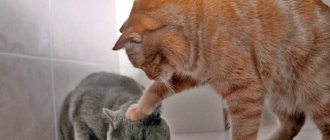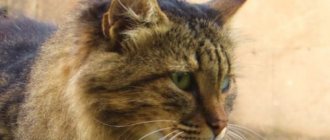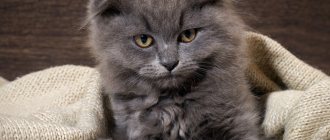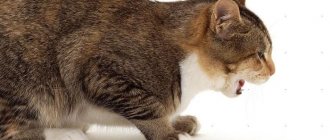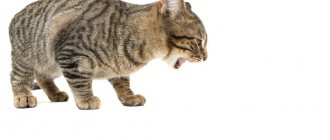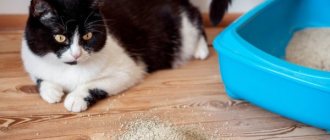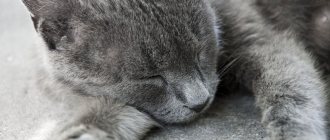Natural Causes of White Vomit
The cat vomits foam with saliva during protective reactions of the body associated with:
- with trichobezoars - accumulation of hairballs in the stomach, which the animal absorbs while licking and regurgitates to release it;
- foreign bodies - in transparent vomit you can find an object eaten by a cat;
- eating grass or indoor plants - the plants irritate the stomach, the pet burps them and begins to diarrhea;
- stress - nervous overstrain leads to the fact that the pet can vomit;
- estrus and sexual heat - loss of appetite, increased anxiety triggers protective mechanisms;
- motion sickness - travel in transport is a common source of illness in pets.
If a cat vomits, this does not always indicate some kind of disease.
Important! The physiological phenomenon does not cause additional symptoms, the cat continues to move actively and eat calmly. It occurs 1-2 times and goes away on its own.
Can vomiting be prevented?
To prevent vomiting you need to:
- periodically treat the cat for worms;
- balance the diet;
- think over the feeding regime;
- undergo a preventive veterinary examination annually and undergo routine vaccinations against infections.
If vomiting is caused by the accumulation of wool in the stomach, then special foods or pastes will help speed up its removal from the digestive tract.
It will not be possible to prevent the ingestion of wool, but you can reduce its entry into the stomach. This can be done with the help of combs, mitten brushes, and furminators.
Causes of vomiting in cats and kittens
Cat vomits yellow liquid with foam
Common factors that cause cats to vomit white foam include not enough or too much food, uremia, and drug poisoning. Each of them has additional clinical signs that the pet owner should pay attention to.
Vomiting with drooling may be due to poisoning
Fasting or overeating
Pets that have undergone spaying or neutering procedures no longer have control over the amount of food they eat. The symptoms are complemented by pieces of overcooked food in white foam. Rapid absorption of food without worry ends with its removal through the nasal passages and oral cavity. Overeating can be determined by mucous contents, large food particles, white foam, and diarrhea.
Prolonged fasting in cats causes a protective reflex due to the body's attempts to get rid of accumulated gastric juice. It irritates the mucous membranes of the stomach, causing reverse peristalsis.
Note! A phenomenon called a hungry gag reflex is observed in cats that careless owners do not feed for more than 48 hours.
Uremia
Cats also vomit foam in cases of renal failure accompanied by uremia. Clinical signs of uremic syndrome are presented:
- drowsiness;
- weakness;
- refusal to communicate;
- a sharp decrease in body weight;
- lack of appetite;
- bad breath.
Animals suffer from a persistent increase in blood pressure, anemia and acid-base balance disorders.
For your information! Cats diagnosed with the disease are registered with a veterinarian and take certain medications for life.
In case of drug poisoning, your pet urgently needs help
Drug poisoning
Non-standard reactions may appear during the treatment or prevention of certain diseases. A cat may vomit when taking:
- potent antibacterial drugs;
- laxatives for constipation;
- medicines against helminths.
Important! Self-medication with any medications can provoke a pathological condition.
What to do if a cat vomits?
If the gag reflex occurred once, the release of vomit quickly ended, and symptoms such as temperature fluctuations, diarrhea, weakness and lethargy are absent, try to alleviate the cat’s suffering on your own. In case of poisoning, the animal should stop feeding; it is better to provide it with a regular drinking regimen. You can give your cat a weak solution of potassium permanganate, which has a bactericidal effect. The maximum “duration” of fasting should not exceed 12 hours. About once every two hours you need to give your fluffy water or a weak solution of Smecta.
After your general condition improves, you can gradually return to your previous diet. You can give small portions of boiled chicken meat, rice water, liquid chicken broth or specialized medicinal food. After two or three days, you can transfer your pet from a gentle diet to a regular one.
Vomiting in a pregnant cat
The cat is vomiting bile and doesn’t eat anything: what to do?
Toxicosis in a cat is a normal physiological phenomenon. Sharp changes in hormonal balance associated with conception and subsequent development of the fetus cause attacks in the first weeks of gestation. In the last stages of pregnancy, the appearance of white foam in the vomit indicates the maximum volume of the uterus and its pressure on the digestive organs.
Note! The physiological phenomenon in the cat does not affect the appetite and general condition. The animal feels good and behaves adequately.
Vomiting food and liquid
Once you know why your cat vomits white foam, you should also understand why this animal can sometimes vomit food and liquid. Typically, this behavior indicates a pathological change in the gastrointestinal tract. In addition, a cat may vomit food even in the case of banal overeating, since these animals have no sense of proportion and can eat gourmet foods in excessive quantities.
But in the case when blood appears in the vomit, it makes sense to be alarmed. The fact is that this may indicate that an infection has entered the animal’s body, or that it has worms. In this case, a visit to the veterinarian is mandatory for preventive purposes in order to prevent infection of both other animals and people.
In addition, vomiting blood can also be a sign that a foreign object has entered the cat's stomach. Pets often lick and swallow various shiny and unknown objects that can be dangerous. So, very often they swallow glass or can damage their internal organs with bones. As a result, internal bleeding begins, which can threaten the life of the animal. Therefore, if you notice blood in the vomit, immediately take your pet to a veterinary clinic.
Vomiting liquid alone is also a cause for concern. The fact is that vomit, consisting of a yellowish liquid, is a sign of feline distemper. At the same time, the animal does not eat, is afraid of light, and its vomiting is strong and painful. If treatment measures are not taken in time, it can die quite quickly, primarily from dehydration.
You should be especially concerned when your cat begins to refuse food. Normally, even a sick animal eats periodically. If it stops doing this, it has a very serious condition. So, the means at hand most likely will not help him, and he will need to go to the nearest veterinary clinic.
By the way, you should never forget about such an unpleasant subject as helminths.
Attention!
Many cat owners, having noticed their vomiting and poor appetite, immediately begin to panic and completely forget that common worms can cause symptoms in animals that are similar to signs of dangerous illnesses.
Therefore, be sure to periodically inspect your animals for worms, because even domestic cats can pick them up by sitting, for example, for a short time in a tray with sand taken from the street.
Causes of vomiting in kittens
Diarrhea and vomiting in a cat: what to do at home
A baby may vomit due to the following factors:
- with a sharp change in the usual diet, especially during weaning from mother’s milk and transition to solid food;
- prepared food of low quality or feeding scraps from the master's table: fatty, smoked, salted, spoiled foods, due to which the stomach is automatically cleansed;
- absorption of food in large pieces (observed in hungry kittens);
- accumulation of fur in the gastrointestinal tract during active licking;
- swallowing foreign objects. Any inedible things become a source of problems and can cause pink vomit;
- poisoning - consumption of medications, detergents, cosmetics, alcoholic beverages or cat litter;
- after vaccination.
Important! Regardless of the source of the kitten's gag reflex, it is necessary to show it to a veterinarian. In complex cases, the problem may be associated with liver diseases, pancreatitis, triaditis, and infectious diseases.
Types of vomiting
In most cases, the cause of vomiting can be determined by the consistency and type of vomit.
- If an animal vomits yellow foam, this means that during the digestion of food a certain amount of bile enters the cat’s stomach. This often happens with gastritis, colitis, and problems with the biliary tract. Against the background of bile secretion, the liver is cleansed of harmful microorganisms and toxic substances. Thus, a cat can vomit due to calcivirosis, feline distemper, a change in food, or a small foreign object entering the stomach.
- The animal vomits clear liquid or saliva due to a rather dangerous disease - distemper. At the same time, the cat can also vomit yellow liquid or foam, which does not contain undigested food and hairballs. With each subsequent urge, the cat gets worse, he becomes lethargic and apathetic, and hides in a dark place. When a cat vomits a clear, almost colorless liquid, its body loses water, which leads to rapid dehydration.
- It happens that a cat may vomit right after eating. The reason for this is intestinal parasites, which are found even in domestic cats. Also, a cat may regurgitate undigested food that is not absorbed by its body. This condition can manifest itself with intestinal obstruction, gastritis, colitis, hepatitis, or pancreatitis. An animal may regurgitate food it has just eaten due to a certain amount of hair that has accumulated in its stomach or due to overeating.
- If helminths live in a cat's body, the cat may well vomit worms. In such a situation, you should take preventive measures, limit your pet’s contact with people and make a visit to the veterinarian. You can start taking antiparasitic drugs only after passing a stool test, which determines the type of worms living in the animal’s body. When treating a cat for worms, clean and fresh water should always be present in its drinking bowl.
Something else interesting: Why doesn’t a cat go to the toilet and should you be concerned?
First aid for an animal
Supportive measures depend on the root causes of deterioration in health:
- in case of poisoning - activated carbon is crushed, dissolved and given to the pet using a syringe (1 tablet per 10 kg of weight);
- in case of paroxysmal short-term vomiting, balance is restored with rehydron solution;
- a weakened pet is supported with injections of ringer's solution, atoxil and enterosgel.
Important! If such a condition in a cat continues for more than 48 hours, then it must be taken to the veterinarian. Further self-medication can lead to the death of the animal.
In any critical situation, it is better to show the animal to a veterinarian
Other reasons
An equally common cause of vomiting with white foam can be hunger and insufficient nutrition of the animal . Nature arranges it in such a way that cats are very sensitive to the food they consume. If there is a shortage of it, the body will continue to produce all the enzymes necessary for digestion in the same quantities for a long time. If a pet does not receive food for a long time, then hydrochloric acid can begin to seriously irritate the animal’s stomach. The result of this phenomenon will be the formation of foamy vomit. For this reason, the duration of a cat's fasting period should not be more than one day.
The same picture can be observed if a large number of hairballs accumulate in the cat’s stomach . Most often this happens with long-haired cats, whose owners do not bother to comb their pet. The result of this attitude towards the animal is that a large amount of wool simply ends up being swallowed by the animal. The result of this is that many dense hairballs form in the stomach, which lead to intestinal blockage and profuse vomiting.
Quite dangerous diseases that lead to foamy vomiting are diseases of the gastrointestinal tract . These diseases can lead not only to the formation of belching in the animal, but also to more serious consequences. And here the safest thing is heartburn in a cat . It will be accompanied by vomiting and white foam in the morning, on an empty stomach.
But gastrointestinal diseases also have other symptoms:
If a cat vomits immediately after eating, this directly indicates problems in the gastrointestinal tract. It is worth remembering that the most dangerous disease in cats is enteritis . This disease causes inflammation of the lining of the small intestine. In this case, vomiting is only one of the symptoms of the disease. Although it is more typical for diarrhea, which does not go away for a long time and greatly exhausts the animal. In this case, impurities of bile and blood may be observed in the vomit.
If you notice that your pet is vomiting bile and this continues for more than a day, then you should immediately take him to the veterinarian, otherwise death may occur.
Diseases of the adrenal glands can have equally serious consequences . If they are damaged by disease, they cannot produce enough cortisone in the body. Therefore, the cat may often vomit and develop diarrhea. The disease can affect animals of different breeds with equal frequency. And here it is very important to quickly notice hormonal changes in the animal’s body and consult a doctor. If treatment is not started on time, the disease can end very badly.
Mandatory visit to the veterinarian
A visit to the animal clinic is necessary for prolonged illness, severe lethargy, or weakness of the pet. If a cat cannot go to the toilet and does not allow her to touch her stomach, then she needs urgent help. Other reasons to contact a veterinarian include:
- frequent attacks, up to several times per hour, subject to a fasting diet;
- complete denial of food, foamy vomit can be a symptom of a serious illness;
- high temperatures, in the range of 39-39 ° C, at which the cat shakes;
- convulsive syndrome - involuntary muscle contractions indicate damage to the central nervous system;
- blood particles in the vomit, diarrhea.
Regular regurgitation of hair indicates a digestive disorder. There is a possibility that the source of the pathological condition is a disease of the gallbladder, rectum or pancreas. When the liver and bile ducts are damaged, the cat begins to drool and vomits yellow contents.
Important! Ignoring the pathological deviation leads to dehydration of the animal's body. Violation of water balance and active removal of useful substances can be a prerequisite for death.
Why does my cat vomit white foam?
Vomiting in an animal is a kind of defensive reaction to the entry of chemical irritants, foreign objects and pathogenic bacteria into the body. A cat vomiting white foam may indicate a malfunction of the biliary system. During the digestion of food in the stomach and its entry into the intestines, the secretion of mucus does not stop, the excess amount of which turns into white bubbles upon contact with air. If in this case the foam has a uniform consistency and nothing is present in it, there is no danger to the cat’s body.
Causes of vomiting in kittens
The kitten vomits white foam in the following cases:
- A sharp transition from one diet to another (for example, the baby has just been weaned from his mother and has been fed full-fledged “adult” food, and his stomach has not yet learned to digest natural food or feed).
- Poor quality, unhealthy food (fatty, fried, salted, smoked, stale food and cheap low-quality food cause a negative reaction and rejection in the kitten).
- Overeating and eating too large pieces of food.
- Getting a large amount of hair into the stomach (with frequent and active licking).
- Accidental ingestion of foreign objects (candy wrapper, toy part, Christmas tree tinsel and other inedible things).
- Poisoning with a substance of chemical origin (medicine, dishwashing liquid, cosmetics, litter, alcohol).
- Possible consequences of vaccination.
- Liver problems, pancreatitis, or triaditis, any infectious diseases.
If the baby vomits, you need to try to find out the exact reason and show the animal to the doctor.
Vomiting in cats
An adult cat vomits for the same reasons as a small kitten. If this happens rarely, there is no need to worry, but if the animal vomits for quite a long time and this condition is periodic, you should immediately contact a veterinarian. The doctor will conduct an examination and establish the correct diagnosis. The inspection consists of the following stages:
- Determining the frequency and duration of vomiting;
- clarification of information about nutrition and the possible ingestion of dangerous objects and substances into the stomach;
- analysis of the type and consistency of vomit, clarifying when the cat vomited for the first time
- analysis of the cat’s general condition, appetite;
- questions to the owner about other chronic or infectious diseases already known to the owner.
Something else interesting: Gastritis in cats and its treatment
If the animal has vomited only once, the vomit is not profuse, has a white or slightly yellowish color, and there are hairballs in it, monitor your animal for 24 hours. Typically, this type of discomfort should go away on its own. The situation becomes serious if the cat feels sick and vomits for more than a day. In this case, the body quickly becomes dehydrated, which can lead to more serious consequences. If at the same time the cat looks sick, lethargic, does not go to the toilet and does not allow his stomach to be touched, a visit to the veterinarian cannot be postponed.
A cat that has not eaten for more than two days and is vomiting periodically may be seriously ill. In such cases, you should take a general blood test, urine test, x-ray and ultrasound of the kidneys and abdominal cavity. Such prolonged vomiting is not physiological in nature and may be a sign of severe food poisoning, plague infection, exacerbation of one of the chronic diseases or panleukopenia.
Important! If hair regurgitation occurs regularly, this indicates improper functioning of the digestive system. This pathology is a consequence of problems with the bile ducts, inflammatory processes of the rectum and pancreatitis.
Diagnosis and treatment
A consultation with a veterinarian begins with a medical history. The doctor asks about the pet’s diet, the time of onset of symptoms, and the presence of chronic diseases or infections. A visual examination, palpation of the abdomen and information received from the cat's owner are necessary to make a preliminary diagnosis. Its confirmation is carried out using laboratory diagnostic examination:
- blood, urine, vomit tests;
- Ultrasound of the abdominal organs and kidneys.
After the final diagnosis is made, the sick cat is prescribed a specific therapy regimen. This includes taking medications and restoring lost fluid.
Anti-vomiting medications for cats
Medications are prescribed by a veterinarian after determining the source of the gag reflex. Frequently used tools:
- cerukal and torekan help get rid of nausea and are safe and effective medications with central action;
- famotidine, omeprazole are necessary to reduce the production of hydrochloric acid;
- Heptral, Chofitol, Essentiale belong to the subgroup of hepatoprotectors, recommended for liver pathologies;
- Smecta, Enterosgel are sorbents prescribed for poisoning.
Some animals are prescribed antispasmodics to suppress pain. Therapy is carried out with papaverine, drotaverine, baralgin, platyphylline.
Use of antibiotics
Antibacterial therapy is prescribed for diagnosed inflammatory processes. Additionally, multivitamin complexes and immunostimulants are prescribed. It is carried out:
- ampicillin;
- streptomycin;
- amoxicillin;
- amoxiclav;
- azithromycin.
Medicines are given in tablets, capsules or injectable solutions. The duration of the course and dosage are determined by the attending physician.
For your information! Antibacterial therapy carried out independently provokes serious complications. Antibiotics in the wrong dosage negatively affect the pet’s heart, liver and kidneys and disrupt the normal microflora of the gastrointestinal tract.
Diet food
If pathology occurs, animals are prescribed therapeutic fasting for the first 12 hours. To replenish the loss of water and electrolyte balance, the pet must have free access to water. He should drink without restrictions, but he cannot be forced. Otherwise, the cat will begin to vomit and vomit water.
Subsequently, he is transferred to a specialized medicinal food intended for cats with digestive problems. Preference is given to canned varieties; hard varieties are more difficult to cope with in the affected gastrointestinal tract. The transition to a normal diet occurs gradually and only with the approval of a veterinarian.
Important! During therapy, the animal should be at home, even if it wants to go for a walk.
Free access to water should be maintained throughout the course of treatment
Cat treatment
Vomiting indicates that human intervention is required. You can do without the help of a veterinary specialist if:
- the pet vomited once;
- there are no impurities in the vomit;
- does not suffer from diarrhea;
- The cat is apparently healthy.
At home, when vomiting, help your pet:
- refrain from feeding for 8 hours;
- eliminate dehydration;
- give an antiemetic if poisoning is excluded;
- in case of poisoning, a sorbent is given;
- treated with a hepatoprotector for regurgitation of bile.
If the cat is dehydrated, Nelit or Trisol are prescribed.
When is it time to see a veterinarian?
An unfavorable indicator if the cat is lethargic, sleeps a lot and refuses to eat, coughs, and tries to hide. You should contact your veterinarian if your gag reflex:
- repeated many times during the day;
- lasts several days;
- does not depend on food;
- observed in the absence of appetite;
- accompanied by diarrhea, colic, muscle weakness, lacrimation.
You should not try to stop vomiting on your own if you suspect poisoning. Large accumulations of hair can only be removed surgically from the stomach.
What to give a cat for nausea?
Brief instructions for giving an injection to a cat.
Sorbents are used against frequent regurgitation:
- Enterosgel;
- Atoxyl;
- Polysorb;
- Activated carbon;
- Enterodesis.
Attempts to give medicine by mouth are sometimes unsuccessful.
In this case, an intramuscular injection of Cerucal or Paspertin is given; the duration of treatment should not exceed 5 days.
To support the liver during bile regurgitation, the hepatoprotector and detoxifier Divopride is given.
Diet food
If blood or bile appears in the vomit, you should visit a veterinarian. If there are no dangerous inclusions in the vomit, the pet vomits no more than three times a day, and its behavior has not changed, then a diet is prescribed.
The duration of the dietary restriction is 2 days, the pet is offered:
- boiled chicken without skin and fat;
- rice broth;
- boiled chicken egg;
- low-fat cottage cheese;
- baby puree;
- medicinal food.
Portions should be small. It is necessary that the animal has constant free access to fresh water.
Carrying out prevention
Prevention of sudden attacks of the gag reflex is carried out with the help of:
- regular anti-worm therapy. For cats walking outside every 3 months;
- annual vaccinations, preventive examinations at a veterinary clinic for timely detection of hidden diseases;
- proper nutrition. Balanced ready-made food in sufficient quantities will help avoid pathological conditions;
- pet care. Brushing will prevent the accumulation of hairballs in the stomach;
- maintaining hygiene in the home. A clean room and no small objects that the cat could swallow.
Combing
White foam along with the contents of the stomach can have both physiological and pathological origin. The appearance of accompanying clinical signs requires seeking professional help and undergoing a full diagnostic examination. Timely treatment will avoid complications and save the life of your pet.
In what cases do we run to the doctor?
This should be done in most situations. If:
- The animal vomits foam or liquid for 3-4 hours;
- vomit is white or yellow, with blood visible in it;
- the potential furry patient vomits for a long time and refuses to eat or drink.
- In addition to the main problem, the cat developed diarrhea, the nose became dry and hot, weakness appeared, the temperature rose and convulsions began.
In such cases, you should not act at your own discretion; you need to contact a veterinary clinic as soon as possible, where the poor fluffy:
- They will make a diagnosis;
- will prescribe antiemetic drugs;
- They will give you a pain reliever that will help eliminate the spasm;
- will prescribe gastroprotectors necessary for the gastric mucosa;
- will prevent dehydration and replenish the lack of fluid with special solutions;
- If necessary, antibiotics and anthelmintic drugs will be prescribed.
The complex of actions described above will help minimize the negative consequences of vomiting and prevent its occurrence in the future.
To prevent more serious diseases, the symptom of which is vomiting, you need to monitor your pet’s diet, get all the necessary vaccinations and carry out regular preventive maintenance against fleas, ticks and helminths. All these measures will help maintain the health of your cat.
Parasites and vomiting
If your pet is vomiting and you want to know why this is happening, then it is worth remembering that parasites can live in the cat's body. When the number of helminths becomes very large, the animal’s body cannot cope with the processing of their waste products . And the cat’s vital organs gradually begin to fail. First, the liver fails and the animal begins to vomit yellow foam.
And severe intoxication of the body itself causes severe vomiting. It will be expressed as a protective reflex of the body that is trying to get rid of toxins. But worms also exert pronounced pressure on the animal’s internal organs, which in itself leads to a gag reflex.
If the animal has been given injections or undergone surgery, then vomiting may become a natural occurrence in this case. Some drugs can cause this effect when ingested by a cat. So, if you suspect that your cat has ingested any medicine on its own or has gotten into contact with any chemical, take it to the hospital immediately. The veterinarian will help deal with the problem and cure your pet.
Owners of cats who live in warm countries and have the possibility of contact with poisonous plants and animals need to be especially careful. After all, the bites of some of them can lead to poisoning and foamy vomit. Quite often, bloody discharge is observed in the vomit. In this case, any delay is fraught with the death of the animal.
And the possibility that the cat could have eaten poisonous grass instead of healthy grass should not be ruled out. Along with vomiting, most of the toxic contents of the stomach will come out, but it is still worth showing the cat to a doctor.
Diagnostics
When contacting a veterinary clinic, you need to provide the specialist with the following information:
- What did the cat feed, were there any changes in the diet.
- How often did vomiting occur?
- Are there any chronic diseases or infections in the animal that the owner is aware of?
This will help establish an accurate diagnosis and take the necessary measures.
Diagnosis of the pathological condition of a cat is as follows:
- analysis of the type and consistency of vomit;
- examination of the cat, analysis of the general condition;
- laboratory tests of blood, urine;
- Ultrasound of the abdominal cavity, kidneys.
The treatment regimen is selected depending on the established diagnosis. It includes drug therapy and measures to prevent dehydration.
During the treatment of vomiting in a cat, a special diet is necessary. Food should be semi-liquid. Feed your pet more often, in small portions. Meat should only be given boiled and chopped. After stabilization of the condition, the transition to the usual diet should be gradual.
First aid for a cat
Regidron helps reduce the intensity of vomiting.
If you are sure that the cat does not suffer from serious diseases, and there are no problems other than vomiting, then you can cope with the situation yourself
:
- Put the cat on a one-day fasting diet
. Over the course of a day, the digestive system will be unloaded, and the body will begin to “come to its senses.” After this time, vomiting should stop. Now you can little by little, but often, feed your pet rice boiled in chicken broth. It is better to start with minimal portions every 2-3 hours. In subsequent days, portions increase, but the number of meals decreases. - Brew mint.
You can use pharmacy tea. The broth should be cooled to 37 degrees and poured into the cat’s mouth. One tablespoon of decoction is enough. You can give it either immediately after vomiting or after several hours. - If your cat often swallows fur, you can give him a teaspoon of vegetable oil 3 times a week.
First aid
If your cat is vomiting water and foam, but is not showing any other symptoms, then you can try to help her even before you take her to the doctor. , a daily fasting diet helps a sick animal feel better . Its meaning is to relieve the body and restore some of its functions. The main thing here is to provide the animal with a sufficient amount of water, warm and boiled.
If the animal’s condition has stabilized after 24 hours and vomiting is no longer observed, then you can gradually begin to give food. The optimal food option in this case would be white rice boiled in broth. The cat should be fed at this time as often as possible, but in small portions so that the digestive system has time to cope with the functions assigned to it. After a week, you can begin to switch the cat to a normal diet.
First aid
If you notice that your cat is vomiting foam, but there are no other dangerous signs, you can do it yourself. It is especially important to know how to help your pet if it is not possible to quickly get to a veterinarian.
First of all, it is necessary to put the animal on a starvation diet. For 12-20 hours after the animal has vomited, you should not give the cat anything to eat. But water must be freely available. When the pet’s condition has stabilized, without repeated vomiting, you can try giving the cat some boiled rice.
The appearance of foam at the mouth of a cat should alert the owner, since there may be several reasons for this phenomenon. If you suspect intoxication of the body, it is necessary to give the animal an enterosorbent (Enterosgel, Atoxil, Activated carbon, Smecta) to quickly remove toxins. You can give antiemetic drugs such as Phenothiazine, Paspertine.
If it is not possible to travel or call a veterinarian at home, it is recommended to call the clinic and ask over the phone for the dosage of medications for your animal, indicating the weight and age of the pet, as well as the presence of accompanying symptoms.
If, after a starvation diet, a cat does not eat and vomits all day, then the cause of this phenomenon may be liver lipidosis and, in the absence of medical intervention, the animal is likely to die.
